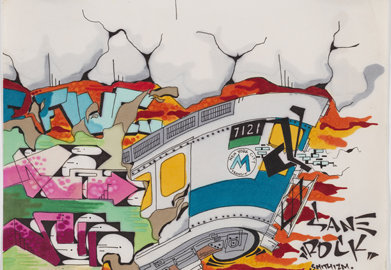In the late 900s, new urban art practices appeared in various cities of the Western world, with the intention of redefining the notion of art in public space. Under the street art label, today we bring together different forms of independent public art which, taking up the codes of pop culture and graffiti art, use the dialogue between the street and the web to give life to decidedly innovative forms.
After ten decades, the socio-cultural phenomenon of urban graffiti has gained a unique relevance in the panorama of contemporary creativity: the works of artists such as Banksy have invaded the major cities of the world, and from the XNUMXs to today Bologna itself has established itself as point of reference for many artists – from Cuoghi Corsello to Blu, passing through Dado and Rusty – who have chosen the city of Felsina to leave their mark on the walls.
From March 18 till June 26, 2016 this art form is told in its evolution, entirety and spectacularity in the halls of Palazzo Pepoli – Museum of the History of Bologna with a large exhibition entitled Street Art – Banksy & Co.
The event will also bring to Italy for the first time the collection of the American painter Martin Wong donated in 1994 to the Museum of the City of New York, presented in the exhibition City as Canvas: Graffiti Art from the Martin Wong Collection, curated by Sean Corcoran curator of prints and photographs of the Museum.
As shown within the exhibition, the section aims to identify New York in the 1980s, in which it will be possible to admire the works of the greatest US graffiti writers and street artists such as Dondi White, Keith Haring, and Lady Pink.
The project stems from the will of Professor Fabio Roversi-Monaco, President of Genus Bononiae, and a group of experts in the field of street art and restoration with the aim of starting a reflection on the principles and methods of safeguarding and conserving these art forms. The "tearing" and restoration project, an experiment conducted by the restoration laboratory Camillo Tarozzi, Marco Pasqualicchio and Nicola Giordani on some Bolognese walls by Blu - one of the ten best street artists in the world as reported by a 2011 The Guardian ranking -, such as the large mural of the ex Officine di Casaralta (Untitled, 2006) and the mural on the facade of the ex Officine Cevolani (Untitled, 2003) otherwise destined for demolition, seemed like a propitious occasion for an exhibition that aims to contribute to the current international debate: for years, in fact, the scientific community has been focusing attention on the problem of safeguarding these testimonies of contemporary art and their eventual and possible "museumization" to the detriment of the original location but in favor of their conservation and transmission to posterity. The Street Art – Banksy & Co. exhibition tells for the first time the influences on the visual arts that street art has had and continues to have, passing through that aesthetic that was born in New York in the 70s thanks to the passion for lettering and the name writing of young people from the suburbs of the city. It exhibits the works of authors associated with graffiti writing and street art, to create similarities between the different productions along the way and explain the way in which they have been received by society.
The artistic heritage is the protagonist of the unprecedented exhibition hosted in Palazzo Pepoli, which with its covered courtyard reproduces what could be a portion of the city, an ideal place to tell an important stage in the history of Bologna.
The utopian purpose and intent are to protect and conserve this art form and to bring current cultural policies to recognize the need for a redefinition of intervention tools in urban space because graffiti - today more than yesterday - influence the world of graphics, people's taste, the entire art of this century.
There are those who consider him a storyteller and those, on the contrary, the only one who has been able to freeze the moment - crystallized in time - of a panorama, as of a person. It was the same Edward Hopper (1882-1967) – the most popular and well-known American artist of the XNUMXth century – a shy and taciturn man, a lover of sea horizons and the clear light of his large studio, to clarify his poetics: “If I could say it in words, I would not there would be no reason to paint”. This second exhibition that opens from 25 March to 24 July 2016 at Palazzo Fava – Palazzo delle Esposizioni in Bologna, from Parisian watercolors to landscapes and city views of the 50s and 60s, through more than 60 works including famous masterpieces South Carolina Morning (1955), Second Story Sunlight (1960), New York Interior (1921), Le Bistro or The Wine Shop (1909), Summer Interior (1909), extremely interesting studies (such as the study for Girlie Show of 1941) which celebrate the hand of Hopper, a superb draftsman: a path which crosses his production and all the techniques of an artist considered today a great classic of twentieth-century painting.
An exceptional loan is the large painting entitled Soir Bleu (it is about two meters long), a symbol of human solitude and alienation, a work created by Hopper in 1914 in Paris.
The exhibition is curated by Barbara Haskell – curator of paintings and sculptures at the Whitney Museum of American Art – in collaboration with Luca Beatrice. The Whitney Museum has hosted various exhibitions by the artist, from the first in 1920 at the Whitney Studio Club to the memorable ones of 1960, 1964 and 1980. Furthermore, since 1968, thanks to the legacy of his widow Josephine, the Museum has housed the artist's entire legacy : over 3.000 works including paintings, drawings and engravings.





